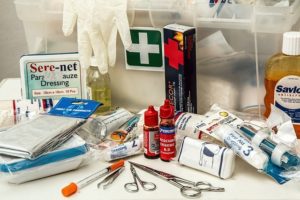A 21-year-old female Medical Student was brought to the emergency department with nausea, vomitting & complaint of abdominal pain. She had been under a lot of stress preparing for her final examinations. In her hostel, her friends noticed an empty bottle of paracetamol near the bed with numerous pills lying on the ground. On arrival to the emergency department, the patient was found distressed with vomiting. Laboratory tests revealed normal white blood cell count; hypokalemia; elevated liver enzymes; paracetamol level was above 200femtogram/ML.
The emergency Dept physician gave a gastric lavage and then prescribed oral N-acetylcysteine. What is the pathophysiology of the liver toxicity? How does N-acetylcysteine helps in this condition?


Paracetamol contains acetaminophen and its overdose is highly toxic to the liver through generation of free radicals ultimately causing necrosis of the liver, particularly the centrilobular area which has limited cyt P450. However, there are antioxidants like glutathione which mop up free radicals in the body. So in the case of overdose of paracetamol, glutathione becomes exhausted and there’s accumulation of generated free radicals.
Having this knowledge, what’s needed is to reverse this toxicity by making sure we generate more glutathione. Thus, N Acetyl cysteine is used, because a key chemical make up of glutathione is cysteine. As a result, N Acetyl cysteine will provide more substrate in form of cysteine to make more glutathione and ultimately there will be mop up of free radicals and less toxicity.
N-Acetyl-P-Benzo-Quinone-Imine(NAPQI) is the metabolite produced in d liver by paracetamol…
When overdosed, the NAPQI mops up(conjugates with antioxidant GLUTATHIONE) and also directly destroys hepatocytes(liver cells)
N-AcetylCysteine, is a precursor of Glutathione, thus mitigates d effect of NAPQI, By producing more Glutathione, which helps the liver cells fight the assault of paracetamol toxicity
The information I got from your status made me do more research than needed but I enjoyed it.
I decided it was acetaminophen induced hepatotoxicity.
The gastric lavage was done prolly because it was in high amounts and within 2hrs when she overdosed if not it would not have been necessary since it takes about 2hr to absorb paracetamol.
Basically, the pathophysiology involves the metabolite N-acetyl-p-benzoquinone(NAPQI) which reduces liver glutathione and directly damages liver cells.
On a normal day with a normal dose, about 5% paracetamol forms this metabolite but glutathione deals with it. but when there is overdose, this percentage is increased leading to more formation of NAPQI then glutathione can’t keep up and it damages liver cells
N-acetylcysteine helps by replenishing glutathione that is necessary to conjugate NAPQI
Pathophysiology of liver toxic:
Paracetamol(APAP) is mostly metabolized (90%) through glucuronidation and sulfation.The remaining is detoxified by hepatic GSH pathway.When intake exceeds maximum therapeutic dose(>4g/d),the normal glucuronidation n sulfation pathway becomes overwhelmed .The hepatic GSH pathway becomes solely responsible for metabolism and can prevent build up of toxic metabolites.However,GSH eventually gets mopped off and metabolites like N-acetylbenzoiminoquinone build up.This can react with hepatocytes and cause cellular proteins damage and release of ROS with eventual hepatotoxicity.
N-acetylcysteine acts as glutathione substitute and mops off accumulated toxic metabolites. More effective when given early after poisoning
Paracetamol(Acetaminophen) is non-toxic under normal dosage.In this case, the lady takes an overdose.
In the metabolism of Paracetamol,it undergoes both phase 1 and phase 2 reaction in the biotransformation reactions
In the phase 1 reaction, it undergoes N-oxidation using cytochrome P450(cyp2E1) to form N-acetyl-benzoquinoneimeine(NAPQ1)
In the phase 2 reaction,the acetaminophen is conjugated with glucoronic acid and sulphate to form acetaminophen glucuronide and acetaminophen sulfate which are excreted
1)When acetaminophen is taken in excess,it causes saturation of the glucoronic and sulfation pathways .Hepatic glutathione is depleted faster than it can be regenerated and then the reactive metabolite( NAPQ1)accumulates.N-acetyl-benzoquinoneimeine binds to cellular proteins causing hepatotoxicity as long as glutathione is available for conjugation.
2) Administration of N-Acetyl cysteine following paracetamol overdose facilitates glutathione synthesis.Glutathione in turn is used to conjugate and detoxify the toxic metabolite